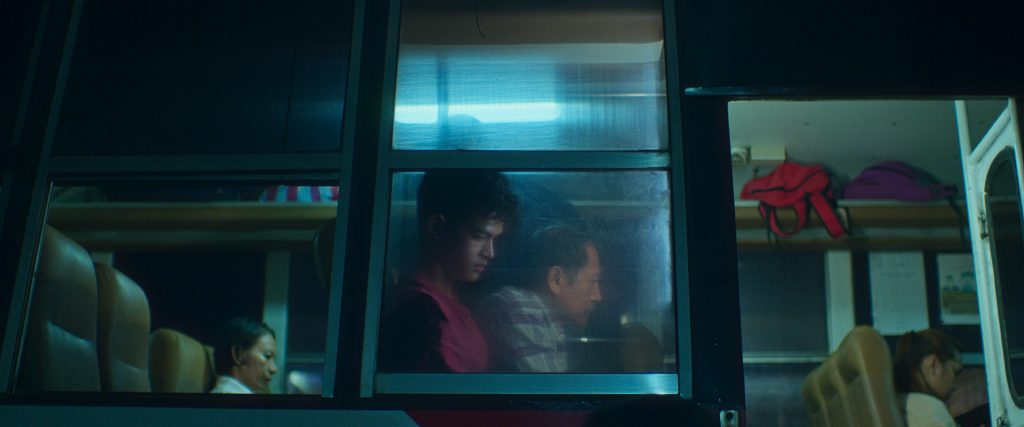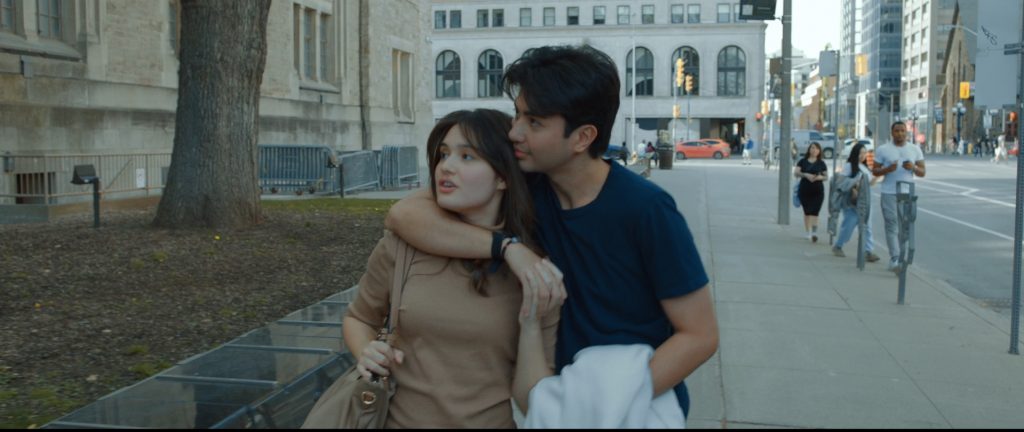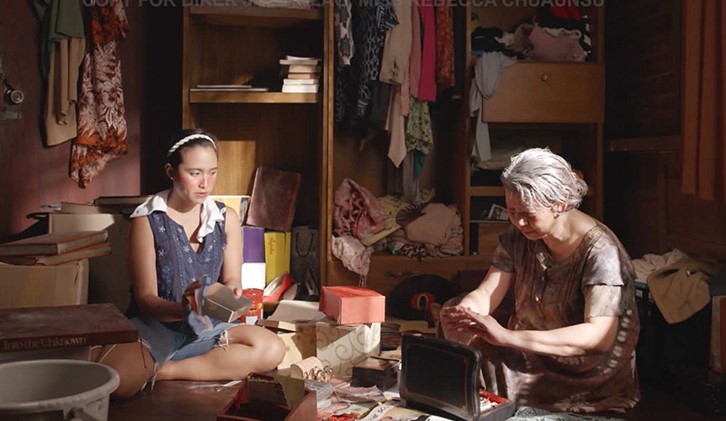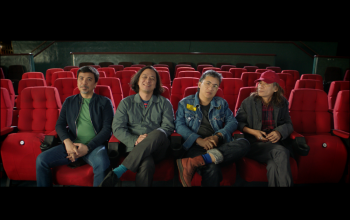Gospel of the Beast: Molded by Darkness
Mateo (Jansen Magpusao) is an ordinary schoolboy who messes around in class. During one particular instance, he accidentally kills a classmate in a fit of anger. Desperate to hide his crime, he turns to his godfather (Ronnie Lazaro), who works as a hitman for an influential person. As he lives out his days under his employ and works his way up the ranks, his faith begins to shake.
People usually do not leave the womb as killers – we may instinctively act out in violent ways, but systematic, purposeful violence is taught, or it permeates so deeply in a society so as to make people accept that this is the way things are. Sheron Dayoc’s The Gospel of the Beast shows a Philippines where violence is so entrenched in our consciousness that when we commit it, the instinct is not to become accountable, but to rationalize it, to find ways to make it more efficient, to escape from its consequences.

While Mateo is himself partly religious – near the start of the film, he prays as his colleagues bury a corpse – his beliefs change gradually as time goes on. His empathy begins to waver, and as he dehumanizes the people he helps kill, he himself loses his humanity. The beast’s religion is violence, the act of killing becomes his prayer. He becomes a tool for others to use for the means of other, equally violent but far more powerful men. Jansen Magpusao’s second feature role after Cinemalaya’s John Denver Trending (2019) cements him as one of the country’s foremost young talents, perfectly embodying Mateo’s descent into beasthood.
There is, however, hope at the ambiguous end of the film, that there is a chance for humanity to be regained, for violence to be unlearned. But it will take a lot of time, effort and a cultural shift that we as a country might not yet be ready to undertake.
(This review is adapted from a series of dispatches from 2023’s Tokyo International Film Fest, where Gospel of the Beast was shown as part of one of its programs.)
Her Locket: Trauma, Healing and Memory
Jewel (Rebecca Chuaunsu) is an elderly Filipino-Chinese woman suffering from dementia. Her lawyer son Kyle (Boo Gabunada) hires a caretaker, Teresa (Elora Españo), to take care of her, and they form a sort of tentative bond, albeit a bond that isn’t completely altruistic. As Jewel recounts her childhood and family situation growing up in a strictly conservative Filipino-Chinese family, she remembers how her brother Magnus (Richard Mata) tricked her out of her share of the family’s inheritance and decides to sue him.
Her Locket is a family drama that in the larger scale of things, doesn’t really do anything new, but it’s a comfortable and generally enjoyable movie to watch. It follows in the slew of films about Filipino-Chinese communities popularized by Joel Lamangan’s Mano Po, and it does that depiction well. It also touches into generational divides and how rigidity and traditional thinking can rip families apart.
However, something feels off about the whole enterprise. Perhaps it’s that the film’s final act (and the decision that resolves it) doesn’t quite align with everything that leads up to it. I get the pivotal character decision near the end of the film, as it is probably a sign of someone who knows they only need to be proven right, as there is no utility to ‘winning’ at this point in one’s life. Perhaps it’s the numerous court scenes, which mostly revolve around seemingly random percentages touted as forensic analysis, and often devolve into hammy, overly theatrical sequences that suspend my disbelief. Or maybe it’s Teresa’s character arc, which doesn’t feel fully realized, showing only a fraction of her interiority, if at all. Or maybe it doesn’t delve too much into Kyle’s own story and how it could mirror his mother’s. But my favorite scene of Her Locket, and perhaps its most effective, is a wordless shot near the end, and Rebecca Chuaunsu and Elora Españo communicate everything that’s needed at that moment. It almost made everything click into place.
Salome: Obliterated Histories and Making Meaning
Andy (Perry Dizon) is a historian. As with many an academic, he is in the process of finishing a book that might never get finished. The years (and an addiction to alcohol) have taken a toll on him and his memory is slipping. After collapsing during a lecture, he goes to live with his translator cousin Christine (Dolly De Leon) in order to recuperate. But visions of a mysterious woman named Salome (Ram Botero) haunt his life, both in waking moments and in dreams.
At a certain level, Gutierrez Mangansakan II’s Salome shares themes and elements with his 2018 film Masla A Papanok: the erasure of culture by colonialist ambitions, that cultural erasure mirrored in its central character’s deteriorating memory, and a woman whose mythohistorical existence is shaped by an amalgamation of multiple cultural elements (Christianity, indigenous religious beliefs, etc), a sort of protean historiography. There is also the looming threat of an apocalyptic event, but while in his earlier film this apocalypse refers to the death of colonized cultures, the events depicted in Salome refers to something equally resonant and immediate.
This is not to say that Salome is a simple reiteration of that earlier film; in particular, the film points at the looming extinction of another set of people: cultural workers and historians like Andy and Christine, and how the reception to the film proves its point.
That’s why I consider the most pivotal scene in the film to be one where Christine and Andy look at the looming horizon and talk about their work. They lament their respective career quagmires and consider the importance (or unimportance) of cultural workers like them. In my view, what they do is of utmost importance: they provide context to text; that is, they help us understand the meanings of art, historical records and photographs. The film notes that historical records (in particular: photographs) have long been used “for the purpose of empire,” To ‘decolonize’ culture we need understanding, and to do that we have to look back and interrogate the intent and history behind the many things left by our former colonizers. Indeed, Christine’s current project involves Antonio Pigafetta’s Primer Viaje en Torno del Globo, which is one of the first books to describe Filipinos from a western perspective. Without the benefit of Christine’s translation and the context provided by historians, how do we make sense of their accounts other than what is presented to us ex facie? Without them, it would be like looking only at one side of the moon, one face eternally facing earth, the other side perpetually locked in darkness.
Salome, whose original name was Dayafan until the colonizers ‘westernized’ her memory and history, can be seen as a sort of parallel to Andy and Christine: she is a prophet, and prophets are conduits, interpreting and translating the language of the divine in order for the common people to understand divine will. She prophesizes a coming calamity and relates the outbreak of a disease in her community that decimated her people. Like the prophets of our indigenous past, historians see cycles and patterns that ostensibly help us prevent them from reoccurring. Alas, as Salome takes place in the last few months and weeks before COVID, these prophecies sometimes reach deaf ears.
There is also one more thing in Salome that metatextually refers to its own utility in this process of decolonization: as it is itself a work of art, there are people whose task is to glean meaning from it. The late David Bordwell once wrote that “the text is inert until a reader of listener… does something to and with it… Meanings are not found but made.” Aside from filmmakers, the cultural workers that do that are film historians and critics, but film critics are as much in danger of extinction as art historians, partly because we as a society are fostering a film watching culture that eliminates nuance, that sees its critics trapped in western formalist discourse, that reduces an opinion to a single number or phrase, and is populated by fundamentally incurious, willfully ignorant people who refuse to engage with a work unless everything is spoonfed to them. That is made more than evident upon reading some of the reactions to this film. To those people, no meaning is created, and nothing will ever be created. To liberate film, to decolonize it as part of decolonizing culture, is to disabuse ourselves of this emerging insipidity and to continue to create meaning, to understand, and to use that understanding to be free.
What You Did: Pandemic Anxieties
Arvin (Tony Labrusca) wants to work, and it looks like he just landed a job in a resort in Palawan. He’s been at it for a while, watching self-help videos in an attempt to give himself an edge. But Arvin’s job hunt comes at the worst time, because it happens just at the cusp of a certain worldwide pandemic…
Trapped in his home with ever more dwindling prospects for work, Arvin begins to lose his mind. He is then ‘visited’ by Ace (also Tony Labrusca) who is Arvin’s total opposite, or rather, his deep-seated Id, acting out in ways Arvin could only imagine doing himself.
What You Did captures the isolation and loneliness a pandemic can bring, and how, for some people, that same pandemic took away their ability to be useful to society. Having to rely on handouts from relatives can feel humiliating. The first part of the film feels like a fugue state, where Arvin’s (and by extension the audience’s) sense of time and place blur.
The isolation of the pandemic made a lot of us turn inward (in introspection) and bring out parts of our psyche that social graces had previously hidden. Through various forms of social media and outlets on the internet, the pandemic revealed something dark about a lot of people – podcasts, for example, went on the rise during the pandemic period, partly because of our desire to be entertained, and partly because of our desire to connect to someone else. It comes as no coincidence that the first thing Ace puts out on the internet (in Arvin’s name) is an insane conspiracy theory, which is just a manifestation of Arvin’s growing paranoia and anxiety – and it also has to be said that people flock to him regardless, like moths attracted to a flame.
What You Did is weakest as it transitions to its latter half, where it tries to provide a justification for Ace’s existence and awkwardly stumbles towards a conclusion. There are some tense moments but the film could have benefited from building up more of it. At this point the pandemic years seem so far away, even though we still had vestiges of it in early 2023. It’s going to be interesting seeing ‘pandemic’ cinema as filmmakers and audiences look at it in retrospect.
(as an aside, getting like 100k views is gonna get you jack shit even if you monetize it lol)
Maple Leaf Dreams: Immigrant Life, Solitude and Community
The first time we see Macky (L.A. Santos, In His Mother’s Eyes) and Molly (Kira Balinger) they’re a couple newly in love. Five years pass since their first meeting, and they’re living a relatively humdrum existence: Macky is a restaurant manager and Molly, like the rest of her family, is subservient to richer relatives, working as an assistant to her cousin. In order to gain financial freedom, Molly decides to immigrate to Canada with Macky, re-enter college there and eventually find a way to get permanent residency and try to move the rest of her family into the country.
Benedict Mique’s Maple Leaf Dreams resonated a bit with me, because it’s the sort of experience my loved ones have experienced: for one, my maternal grandmother spent decades in Ontario until her retirement. Canada has a reputation of being one of the most immigrant-friendly nations in the world, taking in hundreds of thousands of people in the country every year.

The film is pretty rough in its construction: at one point, it uses social media as a narrative device to depict its characters’ feelings, as if everyone in the world is an influencer of some kind. They really don’t need to be gallivanting around the city like it’s one of those “travelogue” Star Cinema films, and the whole thing feels forced.
What Maple Leaf Dreams does successfully articulate, however, is the immigrant experience of many Filipinos seeking a better life abroad. It’s not Canada-specific, the film could have taken place in Azerbaijan and not a lot would change, but it doesn’t need to be. In particular, Maple Leaf Dreams shows how lonely a life abroad can be: years upon years away from family and loved ones, earning money but not for one’s own enjoyment, eternally (and in Molly’s case, ironically) at the service of others. The film shows one of the greatest assets one can have while living in a foreign land: not (just) the monetary compensation, not (just) the affordable healthcare, but the presence of community, the “third space” that forms when people from another culture settle in a wholly different country.
A seemingly superfluous scene, where Molly and Macky leave a steaming hot (!) Christmas dinner for a party with fellow Filipino-Canadians, ends up being the film’s centerpiece. It turns into a documentary style sequence of stories from actual Filipino-Canadians relating their experiences abroad. Mini spoiler alert: it’s not an easy life. And with rising global anti-immigrant sentiment, worsening economies all around the world to the point where even in Canada, immigrants are struggling to make ends meet, it’s not getting any easier for people who are considering taking the risk. But, as the film tries to say in all its clumsy ways, it’s a little bit easier to dream when you have someone dreaming alongside you.
Talahib, Legend of the Tall Grass: The Right to Land
Alvin Yapan’s Talahib begins with a lengthy quotation from retired justice Isagani Cruz. The quote refers to an en banc decision Cruz made in 1989 over the implementation of the Agrarian Reform Law, which was supposed to award land from landowners to farmers. Said landowners protested, saying that the President had no authority to do that, or that they were owed some kind of compensation. Cruz dismissed these petitions and upheld the law, giving the land to the farmers. In his closing statement, Cruz says that “meantime, we struggle as best we can in freeing the farmer from the iron shackles that have unconscionably, and for so long, fettered his soul to the soil.”
If we are to assume that case forms the basis of the film, the opposite seems to have happened: the land itself is possessed by a malevolent spirit, the ghost of a man who was buried there, seeking vengeance upon all that oppressed him. A woman (Sue Prado) and her would-be rapist are killed in the beginning of the film. This leads the local police, led by Bong (Joem Bascon) to investigate. When they run into a group of young people led by Joyce (Gillian Vicencio) at the crime scene, things get a little more complicated.
Talahib is rich conceptually; Yapan is no stranger to allegory, and the land’s seeming malevolence against anyone who walks in its territory is anger distilled from years of unfair treatment. At first watch I was confused: the victims of the Talahib killer call themselves farmers, but they do not do farming; the land is untilled, the grass grows tall and is not reaped. A dilapidated model house stands alone amongst the grass, and there are talks to sell the land for purposes other than farming. These ‘farmers’ are rich and send their children abroad. Then I realized, their testimony of the ghost is false. In my reading of the film, the ‘killer’ is not a ‘killer’, or at least he wasn’t one until after he was killed; the victims of the ‘killer’ are tenants and landowners who call themselves “farmers,” but benefit from land that is not theirs.
That all said, the film is not very well made. From the first frame, I felt a feeling of impatience to the film in its editing and sequencing of events, as if it did not want to bother establishing a scene, filling in narrative blanks, or introducing us to its characters. There’s one time where the characters anxiously search for a character named Vernie, and I was like “who the heck is Vernie?” It’s Kate Alejandrino’s character, but I only knew that after looking at the credits. In another instance, a tense chase inside an abandoned house abruptly cuts to a shot of two policemen waiting outside. The tense chase scene ends off screen and is rarely alluded to again. It’s like massive chunks of the film are missing.
Talahib is a disappointing mess. While it does build some dread in some of its scenes, it is not tense; as a police procedural (for at least 80% of the film, it functions like one) it fails.
Banjo: A Schlocky Action Epic

What makes a film good to me? Is it the cinematography, the editing? Is it its intrinsic entertainment value? I’m not really sure I can answer that right now, but I think one of the factors is how much fun it is, for me and for the filmmakers who made it. Banjo is objectively not a very good film, but I had a blast watching it, and the dedication and passion of the filmmakers is more than evident, despite working with what I assume is 50 pesos and a prayer.
The film begins with Banjo (Bryan Wong, who also directed the film) in dire straits. He was supposed to infiltrate a drug cartel led by crime boss Franko, but his cover is blown and he’s captured by Franko’s underling Zaldy (Rhodium Sagario). Before he is captured, Banjo goes to a fiesta where he sneaks up on a guy stealthily to kill him, ignoring the fact that in the reverse shot there are like five people behind him and he would be spotted immediately.
Zaldy forces Banjo to kill a hooded figure, who turns out to be his brother Marko (AJ Arobo). Banjo then proceeds to kill everyone in that room for making him do that, and sits in the corner after the deed a bloody mess. His pants are also ripped at the crotch area, not intentionally (I think!!!!) but that’s beside the point. Let me tell you this right now: Banjo has a couple of decent action scenes at least in terms of choreography. The camerawork and editing may need a little polishing but there’s something dynamic in these scenes that we don’t usually see in other action films.
The superior officer in charge of Banjo’s operation (Mon Confiado) tells Banjo to continue trying to get to Franko – he’s likely to be chased by Franko’s goons from now on and as long as he doesn’t die, maybe he can get Franko to emerge from hiding and expose him. This is also the last time we see Mon Confiado in the film, because I guess that’s all they have in the budget for his talent fee. In the meantime, however, he has to get the hell out of Zaldy’s base, so he calls his ally Yuri (Missy Acodile) to rescue him. Franko’s goons quickly find out where he is, however, and raid the hideout.
Banjo’s sent to a butcher who’s going to use his body to store contraband (replacing his organs with drugs) while Yuri and a bunch of other women are set to be sold off as sex slaves to a wealthy congressman. Franko’s underling Hector (the late Bordie Carillo) does his sales pitch selling weapons, girls and even parts for nuclear weapons (!!!) Meanwhile, Banjo, Yuri and her new lady friends are in a room. before Banjo is dragged out of the room to be dissected, he defiantly kicks one of the gunmen on his way out! Yuri ends up choking the guy guarding her then she… lies beside the girl next to her??? I have several questions. Why are you storing drugs in dead people? Isn’t lugging a dead person around Mindanao gonna look suspicious? Where did those other women come from? Why did Banjo kick that guy while he was being dragged out of the room???? What happened to the guy Yuri choked into unconsciousness???? What dimension does this take place in???????
Banjo manages to free himself and rescue the hostages and go to a secluded location in Rogongon, Iligan City that used to be a tourist spot. If you’re familiar with Bryan Wong’s previous short films (he has a LOT on his FB page), then you know he likes to shoot in resorts in Mindanao, and that’s also the case here – he shoots in at least two resorts in Banjo, or maybe it’s the same resort and they just shot it in different parts. Here’s where I found the one thing I liked the most about Banjo: it has extensive lore for its huge cast of characters. Banjo meets up with Rakman (Malizord Waway Estillore, and damn that’s a tokusatsu-ass name if I ever saw one) a former rival assassin who Banjo made an ally through the power of friendship. Yuri also recounts how she met Banjo – after some family issues, she becomes a party girl, apparently doing drugs and dancing the night away in a club that has a total of four people in it, tops. Maybe it was a soft opening. After the Rogongon sequence, we don’t see these two people again.
The Rogongon action sequence is probably the film’s centerpiece, as it embodies a lot of things, in all its ultra low budget glory. It understands the flow of an action scene (preparation, action proper, then resolution) but doesn’t quite understand how it fits into filmmaking (what looks like an establishing shot doesn’t match the location where the action actually takes place, and doesn’t quite communicate the locations and positions of its characters in an obvious chase scene). In one glorious moment, Banjo hides under a bridge and snipes Franko’s henchmen one by one. One last henchman falls, but there’s no gunshot – THE POOR MAN JUST SLIPPED ON THE MUDDY GROUND. The take keeps rolling as the man struggles to get up, while a firework effect made to simulate gunfire simmers nearby. He decides not to get up and instead squirms on the ground towards Banjo’s position. I have never felt so much second hand embarrassment for another person in a while. Banjo eventually puts the poor man out of his misery. My eyes are full of tears, but not from crying.
Banjo escapes from Rogongon and goes into hiding, eventually gaining crucial intel left behind by his brother Marko, who happens to have a very pregnant wife (MORE LORE!!!). His new boss, General Laguesma (Jerome Laguesma) is in Los Angeles for some reason, tracking a guy named Dr. Sanders. Why a General would personally be doing a covert operation instead of one of his agents baffles the mind, but whatever.
This review is getting way too long (and I want to keep some spoilers in case you see the film, please release the film somewhere) so let’s just say Banjo always gets his man. I’m telling you though, there’s a ton of things I haven’t even talked about – I sometimes take notes on films I watch and it’s usually 2 pages tops. For this one, I took 10 back to back pages of notes about a truckload of characters with backstories and relationships to Banjo.
It’s like a AliExpress John Wick in here. Among the other characters, of note is Banjo’s daughter (!!!!) who talks with the famed assassin in cutesy language that only proves the point that no matter how badass you are, you’re always gonna act cringe to your kids. This is not a film that was made without thought (okay, yeah it was, filmmaking wise), this story had an outline. This film has lore. Bryan Wong, this absolute madman probably had character sheets. Character sheets!!! He probably even had a relationship chart, this movie has enough material for five sequels. And from the films two (yes, two!!!) mid credit sequences, I would not be surprised.
Banjo proudly continues the tradition of cheap but supremely enjoyable action schlock made with earnestness from truly independent, regional filmmakers. It’s the most fun I’ve had in a cinema all month. I would honestly watch Banjo 2: Franko’s Revenge, Banjo 3: Big Wolf Keeps Slipping On Mud, and Banjo 4: His Pants Ripped Again At the Crotch if they ever had the budget to do so.
All reviews were originally published in John Tawasil’s blog, Present Confusion: click here




